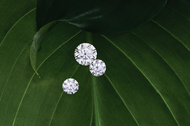Aug 30th 2021
Eco-Friendly Jewelry: Why You Should Consider Lab-Grown Diamonds and Moissanites
Does your special someone care about the environment? Are you looking for an engagement ring that fits their environmentally-conscious personality? Look no further! We’re here to help you understand sustainable jewelry options so you can make the perfect choice for your better half!
But first, some background. You can choose from three types of center stones when shopping for an engagement ring: natural diamonds, lab-grown diamonds and moissanites. As the name suggests, lab-grown diamonds are created in a laboratory, but they’re still real diamonds! Moissanites are an alternative option to diamonds, a rare gemstone, and are also created in a laboratory.
Although debate still exists over the most eco-friendly choice, some in the jewelry industry argue that lab-grown gemstones have an edge over natural diamonds. Here’s why:
No Mining
Natural diamonds were formed billions of years ago below the Earth’s surface and must be extracted in mines across the world. This can therefore be a difficult and expensive process. According to a 2015 report from the Diamond Council of America, miners might need to move a combined 30 tons of ore and rock just to create one carat of a gem-quality diamond! The process could ultimately disrupt nearby wildlife, fertile land and water supply.
Since lab-grown diamonds and moissanites are created in laboratories, they have less impact on surrounding land and natural resources.
Water Usage and Pollution
It’s pretty simple; lab-grown diamonds require less water than their natural counterparts. A lab-grown diamond reportedly uses 18 gallons of water per carat, while a natural diamond uses seven times more gallons per carat. Mining natural diamonds can also contribute to water pollution, as acidic water and minerals sometimes drain out of the mined rocks and flow into bodies of water.
Energy Efficiency
Lab-grown diamonds are created via two methods: High Pressure High Heat (HPHT) and Chemical Vapor Deposition (CVD). The HPHT method basically mimics the conditions that created diamonds below the Earth’s surface, while the CVD method uses high heat to separate carbon atoms from their molecules. The atoms then settle like snow onto a flat surface and eventually form a diamond.
Depending on the mine and laboratory, the amount of energy needed to produce natural and lab-grown diamonds varies quite a bit. According to research from the University of Vermont’s Institute for Environmental Diplomacy and Security, certain diamond laboratories use significantly less energy (between 20 and 30 kilowatt-hours per carat) than certain mines (between 60 and 81 kilowatt-hours per carat).
Some environmental experts say it’s also important to note the type of energy used to produce diamonds. Most HPHT lab-grown diamonds are primarily made from coal energy, a non-renewable energy source. So, choose your lab-grown gemstones wisely!
Have a question? We can help!
Gage Diamonds is Chicago's premier jewelry showroom and online retailer of engagement rings, wedding bands, and fine jewelry. We offer a selection of dazzling lab-grown diamonds as well as Gage Select and Charles & Colvard moissanite rings.
We’re committed to helping you find the ring of your dreams. For inspiration, browse our selection of jewelry or set up an appointment with a member of our trusted staff at our in-person showroom.
We offer no-credit-needed financing – feel free to apply and get your approval within 24 hours!
Pay over time, because love shouldn’t wait.
 VISIT OUR SHOWROOM
VISIT OUR SHOWROOM Reviews on Google!
Reviews on Google!





